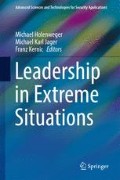Abstract
The 2002 Battle of Takur Ghar, also known as the Battle on Roberts Ridge, illustrates the challenges of learning from experience in extreme situations. The analysis follows the first hour of the battle and the events leading up to the battle. We propose a four-phase model of how leaders learn to operate effectively in extreme situations and identify the importance of judgment-based learning in extreme situations. Drawing on research from crisis and disaster, organizational resilience, and performance under stress, the events reveal the challenges faced by leaders operating in extreme situations. These challenges include unreliable information, situational novelty, unclear and shifting goals, and ill-structured situations. Three concepts—thrownness, depaysement, and collateral learning—are introduced into the lexicon of leadership in extreme situations to describe how leaders might overcome these challenges. The chapter suggests that the often-quoted statement, “trust your training,” may not be enough to help leaders working in extreme situations and might be augmented with the command “trust your judgment.”
Access this chapter
Tax calculation will be finalised at checkout
Purchases are for personal use only
References
Allen NL (2006) Leader development in dynamic and hazardous environments: company commander learning in combat. Unpublished doctoral dissertation, The George Washington University, Washington, DC
Allen NL, Kayes DC (2011) Leadership development in dynamic and hazardous environments: company commander learning through combat. In: McKee A, Eraut M (eds) Learning trajectories, innovation and identity for professional development, vol 7. Innovation and change in professional education series. Springer, New York, NY, pp 93–112
Beilock SL, Carr TH (2001) On the fragility of skilled performance: what governs choking under pressure? J Exp Psychol Gen 4:710–725
Beilock SL, Carr TH (2002) When paying attention becomes counterproductive: impact of divided versus skill-focused attention on novice and experienced performance of sensorimotor skills. J Exp Psychol: Appl 8(1):6–16
Boin A (2006) Organizations and crisis: the emergence of a research paradigm. In: Smith D, Elliott D (eds) Key readings in crisis management. Routledge, New York, NY, pp 84–98
Daft RL, Weick KE (1984) Toward a model of organizations as interpretation systems. Acad Manag Rev 9:284–295
Dewey J (1938) Experience and education. Simon & Schuster, New York, NY
Dreyfus HL (1995) Being-in-the-world. MIT Press, Cambridge, MA
Elmes M, Barry D (1999) Deliverance, denial and the death zone: a study of narcissism and regression in the May 1996 Everest climbing disaster. J Appl Behav Sci 35:163–187
Kayes DC (2004) The 1996 Mt. Everest climbing disaster: the breakdown of learning in teams. Hum Relat 57:1236–1284
Kayes DC (2006) Destructive goal pursuit: the Mount Everest disaster. Palgrave-Macmillan, Basingstoke, UK
Kayes DC (2015) Organizational resilience. Oxford University Press, New York, NY
Kayes DC, Allen N, Self N (2013) Integrating learning, leadership, and crisis in management education: lessons from army officers in Iraq and Afghanistan. J Manag Educ 37:180–202
Kayes AB, Kayes DC (2016) Judgment-based learning: towards an epistemology of problem-solving in management education. Unpublished working paper. The George Washington University
King PM, Kitchener KS (1994) Developing reflective judgment. Jossey-Bass, San Francisco, CA
Klein G (1999) Sources of power. MIT Press, Cambridge, MA
Klein G (2008) Naturalistic decision making. Hum Factors 50:456–460
La Porte T (1988) The Unites States air traffic system: increasing reliability in the midst of rapid growth. In: Mayntz R, Hughes TP (eds) The development of large technical systems. Westview Press, Boulder, CO, pp 214–244
MacPherson M (2005) Roberts ridge. Bantam Dell, New York, NY
Naylor S (2005) Not a good day to die. Berkley Books, New York, NY
Palmer RE (1969) Hermeneutics. Northwestern University Press, Evanston, IL
Perrow C (1999) Normal accidents. Princeton University Press, Princeton, NJ
Phillips S (2006) Rescue on roberts ridge. Dateline NBC. http://www.msnbc.msn.com/id/13233811/ns/dateline_nbc/t/rescue-roberts-ridge/. Accessed 15 Nov 2016
Sagan SD (1993) The limits of safety: organizations, accidents, and nuclear weapons. Princeton University Press, Princeton, NJ
Sears RL (1985) A new look at accident contributors and implications of operational and training procedures. In: Proceedings of the flight safety foundation 38th international air safety seminar, Boston, MA
Self N (2008) Two wars. Tyndale, Carol Stream, IL
Smith D, Elliott D (2007) Exploring the barriers to learning from crisis: organizational learning and crisis. Manag Learn 38(5):519–538
Smith TW (2006) The book of human emotions. Little Brown, New York, NY
Turner BA (1976) The organizational and interorganizational development of disasters. Adm Sci Q 21:378–397
Turner VW (1964) Betwixt and between: the liminal period in ‘rites de passage. In: Proceedings of the American ethnological society, pp 46–55
Useem M, Cooke JR, Sutton L (2005) Developing leaders for decision making under stress: wild land firefighters in the South Canyon fire and its aftermath. Acad Manag Learn Educ 4:461–485
Vince R (2001) Power and emotion in organizational learning. Hum Relat 54:1325–1351
Vince R, Reynolds M (2004) Organizing reflection. Ashgate, London, UK
Weick KE (1995) Sensemaking in organizations. Sage, Thousand Oaks, CA
Weick KE (2004) Designing for thrownness. In: Boland RJ, Collopy F (eds) Managing by design. Stanford University Press, Stanford, CA, pp 74–78
Wilensky HL (1967) Organizational intelligence. Basic Books, New York, NY
Author information
Authors and Affiliations
Corresponding author
Editor information
Editors and Affiliations
Rights and permissions
Copyright information
© 2017 Springer International Publishing Switzerland
About this chapter
Cite this chapter
Kayes, C., Allen, N., Self, N. (2017). How Leaders Learn from Experience in Extreme Situations: The Case of the U.S. Military in Takur Ghar, Afghanistan. In: Holenweger, M., Jager, M., Kernic, F. (eds) Leadership in Extreme Situations. Advanced Sciences and Technologies for Security Applications. Springer, Cham. https://doi.org/10.1007/978-3-319-55059-6_15
Download citation
DOI: https://doi.org/10.1007/978-3-319-55059-6_15
Published:
Publisher Name: Springer, Cham
Print ISBN: 978-3-319-55058-9
Online ISBN: 978-3-319-55059-6
eBook Packages: Business and ManagementBusiness and Management (R0)

